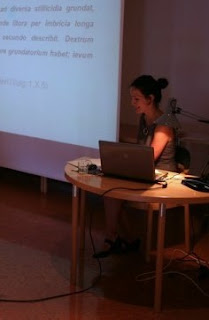I got in November the good news that I will be working upon my project Changing group identities in the multicultural pre- and postcolonial central Italy in 2016–2018 at the Department of Archaeology and Classical Studies with the funding from the Swedish Research Council (Vetenskapsrådet). Even if the subject matter falls within classical archaeology and ancient history, my ultimate goal is to develop a general model for characterising multicultural group identities that can be applied at least in part in any geographic area or archaeological period. My own research questions relate to a specific historical and cultural situation that led to the creation of the Roman Empire and I will specifically explore the importance of multiculturality as a precondition to certain historical developments.
Those who read this blog regularly – especially if they read my ‘mummy blog’ as well - may not be surprised that I am interested in multiculturality. I am after all a Finn, living with my husband and son in UK, now again working in Sweden and studying Italian archaeology. We are monolingual at home, versing in English due to my son’s speech difficulty, but my son does go every now and then to the Finnish Saturday School in the East Midlands. Some weeks ago he suddenly did ask what a Minecraft pickaxe is in Finnish. Maybe all is not lost on multicultural and multilingual front.
In my work I will contextualise my interest in colonial archaeology to the precolonial and postcolonial situations in relation to Latin colonisation that defines the geographic extent of the study area. I will use my ongoing research in the Faliscan area in south Etruria as my key case study area and compare its relationship to other cultural areas in the region. Both my postdoctoral project, The boundaries and territorial geographies of Archaic and early Roman central Italy, and this new project as its extension are built upon my fieldwork within the Nepi Survey Project and the Remembering the Dead excavation project at Crustumerium (Rome). These projects made me interested in intercommunity interaction and its different outcomes in the region (cf. Rajala 2012; in press) and resulted in me starting working towards the theoretical framework of my current research.
And here I must go a bit mum. The characterisation of group identities in this study will be based upon Social Identity Theory (SIT; Tajfel & Turner 1986) but more about this later, possibly somewhere near you. I already gave a presentation in our departmental research seminar to the joined audience of archaeologists from general archaeology, classical archaeology, laborative archaeology and other lines of research we have at Stockholm. I was on Friday invited to give a seminar at Lund. Then already on Wednesday, when I also gave my departmental seminar, I received the surprising news that my paper had been accepted to the Theoretical Roman Archaeology Conference (TRAC) in Rome.
I had made unsuccessful attempts to get a very lovely inscriptions session with nicely gender-balanced speaker panel to the RAC, a shorter panel to the TRAC and two papers to the RAC. Well, at least one of those got a new life as a poster and the organiser of one session with a considerable number of papers to turn down may edit a book of the entire body of material. The organisers were in a happy position to be able to pick up the best of the best of a staggering numbers of entries, so I can sympathise - I was going to go anyway, since the programme will be the cream of the selection. My TRAC paper at least does, as my current research, have a very theoretical core, so this year my paper cannot be turned down from the proceedings on the basis of ‘not being theoretical enough’ (in comparative terms - I plainly assume they had difficulties at Leicester to fit in all the invited 30th anniversary papers and there were many extremely interesting papers). Of course, it may have read a little flat in comparison of the others in probably a highly contested abstract submission. Nevertheless, the RAC-TRAC has so many sessions and papers that I assume a TRAC publication will not come out from this one either. In any case, it all looks great fun. There are already so many of my Finnish, Swedish and British colleagues lined up that the TRAC party should give great time. Unless my paper will be on Saturday morning AFTER the party. Then I will not at least have headache... Back to drinking tonic water with lemon and ice in that case.
Importantly, my discourse will be interdisciplinary between Etruscology, Roman archaeology and Roman history and combine theoretical elements from different social and humanistic disciplines. In addition, my project is linked to the separate research project of Dr Karin Westin Tikkanen at the University of Gothenburg in classics, studying the earliest alphabet signs in Italy, also funded by the Swedish Research Council (Vetenskapsrådet), so the future will be pretty exciting! It may even be awesome.
Rajala, U., 2012. ‘Political landscapes and local identities in Archaic central Italy – Interpreting the material from Nepi (VT, Lazio) and Cisterna Grande (Crustumerium, RM, Lazio). In S. Stoddart and G. Cifani (eds.), Landscape, ethnicity and identity in the archaic Mediterranean area, 120-143. Oxford.
Rajala, U. in press. Nested identities and mental distances: Archaic burials in Latium Vetus. In E. Perego and R. Scopacasa (eds.), Burial and Social Change in Ancient Italy 9th–5th century BC. Oxford. This is actually coming finally out in late April or so!
Tajfel, H. & Turner, J.C. 1986. The social identity theory of intergroup behaviour. In S. Worchel & W.G. Austin (eds.), Psychology of Intergroup Relations, 7-24. Chicago.






No comments:
Post a Comment